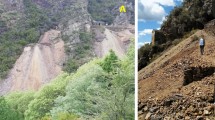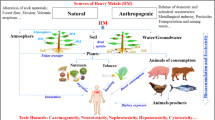Abstract
Toxic metals introduced into aquatic environments by human activities accumulation in sediments. A common notion is that the association of metals with acid volatile sulfides (AVS) affords a mechanism for partitioning metals from water to solid phase, thereby reducing biological availability. However, variation in environmental conditions can mobilize the sediment-bound metal and result in adverse environmental impacts. The AVS levels and the effect of AVS on the fate of Cu, Cd, Zn, Ni in sediments in the the Changjiang River, a suboxic river with sandy bottom sediment and the Donghu Lake, a anoxic lake with muddy sediment in China, were compared through aeration, static adsorption and release experiments in laboratory. Sips isotherm equation, kinetic equation and grade ion exchange theory were used to describe the heavy metal adsorb and release process. The results showed that AVS level in the lake sediment are higher than that of the river. Heavy metals in the overlying water can transfer to sediments incessantly as long as the sediment remains undisturbed. The metal release process is mainly related to AVS oxidation in lake sediment while also related to Org-C and Fe–Mn oxyhydroxide oxidation in river sediment. The effect of sulfides on Zn and Ni is high, followed by Cd, and Cu is easy bound to Org-C. AVS plays a major role in controlling metals activity in lake sediment and its presence increase the adsorption capacity both of the lake and river sediments.
Similar content being viewed by others
References
Ankley, G.T., Di Toro, D.M. and Hansen, D.J.: 1996, ‘Technical basis and proposal for deriving sediment quality criteria for metals’, Environ. Toxicol. Chem. 15, 2056–2066.
Berner, R.A.: 1967, ‘Thermodynamic stability of sedimentary iron sulfides’, Am. Inst. Sci. 265, 773–785.
Brumbaugh, W.G., Ingersoll, C.G., Kemble, N.E., May, T.W. and Zajicek, J. L.: 1994, ‘Chemical characterization of sediments and pore water from the upper Clark Fork River and Milltown reservoir, Montana’, Environ. Toxicol. Chem. 13, 1971–1983.
Bryan, G.W. and Langston, W.J.: 1992, ‘Bioavailiability, accumulation and effects of heavy metals in sediments with special reference to United Kingdom esturaries: A review’, Envrion. Pollut. 76, 89–131.
Campbell, P.G.C., Lewis, A.G., Chapman, P.M., Crowder, A.A., Fletcher, N.K., Imber, B., Luoma, S.N., Stokes, P.M. and Winfrey, M.: 1988, Biological Available Metals in Sediments, National Research Council of Canada, NRCC27694, Québec, Canada, 298 pp.
Carignan, R.F. and Tessier, A.: 1995, ‘Sediments pore water sampling for metal analysis: A comparison of techniques’, Geochim. Cosmochim. Acta 49, 2493–2497.
Di Toro, D.M., Harrison, F. and Jenne, E.: 1987, ‘Synopsis of discussion session 2. Environmental fate and compartmentaliations’, in K.L. Dickson, A.W. Maki and W.A. Brungs (eds.), Fate and Effects of Sediment-Bound Chemicals in Aquatic Systems, Pergamon, Elmsford, NY, USA, pp. 136–147.
Di Toro, D.M., Mahony, J.D. and Hansen, D.J.: 1990, ‘Toxicity of cadmium in sediments: Role of acid volatile sulfide’, Environ. Toxicol. Chem. 9, 1487–1502.
Di Toro, D.M., Zarba, C.S. and Hansen, D.J.: 1991, ‘Technical basis for establishing sediment quality criteria for nonionic organic chemicals using equilibrium partitioning’, Environ. Toxicol. Chem. 10, 1541–1583.
Di Toro, D.M., Mahony, J.D. and Hansen, D.J.: 1992, ‘Acid volatile sulfide predicts the acute toxicity of cadmium and nickel in sediments’, Environ. Sci. Technol. 26, 96–101.
Griethuysen, C.V., Gillissen, F. and Koelmans, A.A.: 2002, ‘Measuring acid volatile sulphide in floodplain lake sediments: Effect of reaction time, sample size and aeration’, Chemosphere 47, 395–400.
Hebert, E. Allen, Fu, G.M. and Deng, B.L.: 1993, ‘Analysis of acid-volatile sulfide (AVS) and simultaneously extracted metals (SEM) for the estimation of potential toxicity in aquatic sediments’, Environ. Toxicol. Chem. 12, 1441–1453.
Helfferich, E.: 1962, Ion Exchange, McGraw-Hill, New York.
Lin, S. and Morse, J.W.: 1991, ‘Sulfate reduction and iron sulfide mineral formation in Gulf of Mexico anoxic sediments’, Am. J. Sci. 291, 55–89.
Luoma, S.M.: 1989, ‘Can we determine the biological availability of sediment-bound trace elements?’, Hydrobiologia 176–177, 379–396.
Morse, J.W., Millero, F.J., Cornwell, J.C. and Rickard, D.: 1987, ‘The chemistry of hydrogen sulphide and iron sulphide systems in natural waters’, Earth Sci. Rev. 24, 1–42.
Simpson, S.T., Apte, S.C. and Batlekny, G.E.: 2000, ‘Effect of short-term resuspension events on the oxidation of cadmium, lead, and zinc sulfide phase in anoxic estuarine sediments’, Environ. Sci. Technol. 34, 4533–4537.
Song, Y.S. and Müller, G.: 1999, Sediment-Water Interactions in Anoxic Freshwater Sediments – Mobility of Heavy Metals and Nutrients, Springer-Verlag Berlin, Heidelberg.
Tessier, A. and Campbell, P.G.C.: 1987, ‘Partitioning of trace metals in sediments: Relationship with bioavailability’, Hydrobiologia 149, 43–52.
Van den Berg, G.A., Loch, J.P.G., Van der Heijdt, L.M. and Zwolsman, J.J.G.: 1998, ‘Vertical distribution of acid-volatile sulfide and simultaneously extracted metals in a recent sedimentation area of the river Meuse in the Netherlands’, Environ. Toxicol. Chem. 17, 758–763.
Yu, K.C., Tsai, L.J., Chen, S.H. and Ho, S.T.: 2001, ‘Chemical binding of heavy metals in anoxic river sediments’, Water Res. 35, 4086–4094.
Author information
Authors and Affiliations
Corresponding author
Rights and permissions
About this article
Cite this article
Tao, F., Jiantong, L., Bangding, X. et al. Mobilization Potential of Heavy Metals: A Comparison Between River and Lake Sediments. Water Air Soil Pollut 161, 209–225 (2005). https://doi.org/10.1007/s11270-005-4284-9
Received:
Accepted:
Issue Date:
DOI: https://doi.org/10.1007/s11270-005-4284-9




